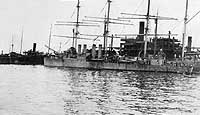
Quevilly, a 3271 gross ton 322-foot long four-masted steel sailing bark fitted as an oil tanker, was completed at Grand Quevilly near Rouen, France, in 1897. In an effort to extend the economic life of previously-subsidized French merchant sailing vessels, she was fitted in 1910 with a pair of 300-horsepower auxiliary diesel engines, driving two propeller shafts. This unusual French vessel was included in the list of ships that were to comprise the Naval Overseas Transportation Service (NOTS), a U.S. Navy logistics force established by a Chief of Naval Operations' order signed on 9 January 1918. Since she was not yet in Navy hands, the bark was listed as "to be taken over." Quevilly sailed from France on 2 February 1918 and arrived in the Azores on 21 February. She operated there for the rest of the war as a station tank ship, providing fuel in port to NOTS and other ships. Although probably under some form of NOTS control, Quevilly was never commissioned in either NOTS or the regular U.S. Navy and remained a privately owned French vessel manned by a French crew. She remained in this status until 12 April 1919, when she was delivered to her Master as agent for her owners.
Laid up in 1921, Quevilly was sold to a Norwegian owner in 1923, re-engined in 1924 with a single 209-horsepower diesel engine driving a single screw, renamed Deodata in 1925, and derigged and converted to a whale oil tanker in 1926. She was sunk on 21 October 1939 off the English east coast near Hull by a mine laid by the German submarine U-19.
This page features the only views we have concerning the French Sailing Bark/Oil Tanker Quevilly, which was later renamed Deodata.
| If you want higher resolution reproductions than the digital images presented here, see: "How to Obtain Photographic Reproductions." |
Click on the small photograph to prompt a larger view of the same image.
Quevilly is probably visible, somewhat distantly, on the right side of the following photograph:
| If you want higher resolution reproductions than the digital images presented here, see: "How to Obtain Photographic Reproductions." |
Page made 31 May 2008